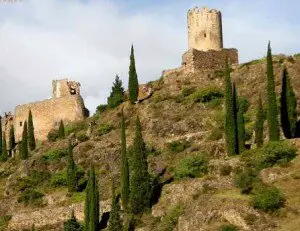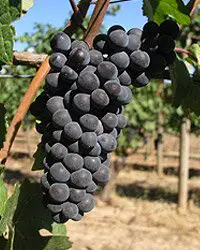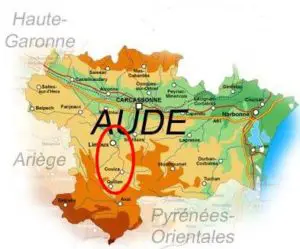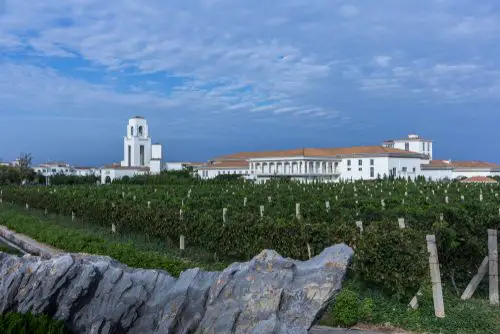 Burgundy may be the home of great Pinot Noir but if you know where to look you can pick up some amazing discoveries that don’t command a hefty price tag. In France, Pinot Noir is also found in the Haute Vallée de L’Aude, where it produces wines of great quality.
Burgundy may be the home of great Pinot Noir but if you know where to look you can pick up some amazing discoveries that don’t command a hefty price tag. In France, Pinot Noir is also found in the Haute Vallée de L’Aude, where it produces wines of great quality.
 The Haute Vallée de L’Aude follows the path of the river Aude through Cathar country in the far south west of France. Here the mountains reach up to 2000ft above sea level as they rise to form the Pyrenees. At this altitude Burgundy’s signature red grape, Pinot Noir, has found a second home.
The Haute Vallée de L’Aude follows the path of the river Aude through Cathar country in the far south west of France. Here the mountains reach up to 2000ft above sea level as they rise to form the Pyrenees. At this altitude Burgundy’s signature red grape, Pinot Noir, has found a second home.
This is a grape that likes cool climates and light soils. Flourishing amidst this elevated terroir; warmed by the Mediterranean sun, tempered by the coolness of the mountains and swept by winds bearing down from the Atlantic Ocean, the Pinot Noir grown here produces pure and elegant wines.
A lovely example is Le Petit Toque. Made by the pioneering local cooperative, Le Petit Toque (the Little Crack) is named in honour of the region’s charity auction, Toques et Clochers (Cracks and Steeples). The auction raises money to repair the 42 bell towers belonging to the of the appellation. The aim is to preserve local historical heritage and architecture. Every year a village is selected to host the festival which attracts almost 30,000 people to the village streets and celebrates the renovation of its church. It is also a major event in the wine world – it is the second largest wine auction in France after Burgundy’s Hospices de Beaune and has been organised by the cooperative since 1990.
 A superb food wine, Le Petit Toque is 12% abv and pairs beautifully with duck, beef, lamb, pork, bacon, pigeon, venison, guinea fowl and poultry. You can serve it slightly chilled as is the custom in the north of France. It also marries well with grilled salmon, tuna and mackerel, dishes with rich sauces, mushrooms and hard cheese.
A superb food wine, Le Petit Toque is 12% abv and pairs beautifully with duck, beef, lamb, pork, bacon, pigeon, venison, guinea fowl and poultry. You can serve it slightly chilled as is the custom in the north of France. It also marries well with grilled salmon, tuna and mackerel, dishes with rich sauces, mushrooms and hard cheese.
 About Pinot Noir
About Pinot Noir
Pinot Noir is the noble grape that makes the great wines of Burgundy and evokes passion in those who fall in love with it. It’s also one of the most studied grapes in the world. In 2007 it became the first fruit crop to have its genome (genetic map) sequenced, showing the handiwork of master wine growers going back to the Stone Age.
Pinot Noir’s origins are so ancient it’s believed that it’s only one generation away from the wild grape and it’s possible that it originated in Gaul where wild vines could have been domesticated.
 Some point to the Roman writer Columella who described a grape in Burgundy in the 1st century growing in Burgundy so similar that they believe it must be Pinot Noir itself. Potentially Pinot Noir could be the oldest cultivated grape.
Some point to the Roman writer Columella who described a grape in Burgundy in the 1st century growing in Burgundy so similar that they believe it must be Pinot Noir itself. Potentially Pinot Noir could be the oldest cultivated grape.
It’s certainly the patriarch of the Pinot family and is the ancestor of many traditional French grape varieties thanks to its ‘marriage’ with the ancient grape Gouais Blanc (some of these include Chardonnay, the Beaujolais grape Gamay, Aligoté and the Muscadet grape Melon de Bourgogne).
 By 1375 Pinot Noir had acquired it’s name, which is taken from the French for ‘pine’ and ‘black,’ as the grapes grow in tight clusters on the vine resembling pine cones. It was jealously protected in Burgundy in 1395 by the Duke, Philippe the Bold, who insisted that the production of Gamay be outlawed so as to favour the better wines made by Pinot Noir.
By 1375 Pinot Noir had acquired it’s name, which is taken from the French for ‘pine’ and ‘black,’ as the grapes grow in tight clusters on the vine resembling pine cones. It was jealously protected in Burgundy in 1395 by the Duke, Philippe the Bold, who insisted that the production of Gamay be outlawed so as to favour the better wines made by Pinot Noir.
The grape needed protecting; it can be difficult to grow as it is very thin skinned and the tightly packed grapes make it susceptible to rot. However the wines it produces are well worth it – they have notoriously been described as ‘sex in a glass’.

Pinot Noir is very sensitive to its environment and can reflect subtle differences in terroir. Planted somewhere too hot the grape will ripen too fast losing all the haunting nuances of flavour it is famous for.
Despite the fact that it’s a tricky grape to nurture in the vineyard it instills an almost obsessive quest for perfection in those who cultivate it. The winemakers of the Haute Vallée de L’Aude are no exception.
 Home to the headwaters of the river the Haute Vallée de L’Aude is criss-crossed by narrow and deep gorges that feed streams down the mountain sides.
Home to the headwaters of the river the Haute Vallée de L’Aude is criss-crossed by narrow and deep gorges that feed streams down the mountain sides.
The area is famous for its unspoilt beauty and wild flowers, especially its orchids (it has over 80 different species). Pinot Noir thrives here as at this altitude it’s cool and airy – the Aude is one of the windiest regions in France.
 Although snow falls here in the winter and the rainfall can be high, the proximity to the warm Mediterranean means that the Pinot Noir grapes ripen fully but slowly.
Although snow falls here in the winter and the rainfall can be high, the proximity to the warm Mediterranean means that the Pinot Noir grapes ripen fully but slowly.
Harvest takes place here a full month later than that on the plain below. Wines made on this terroir are fresh and vibrant.
They may be hard to find but once discovered they are a true revelation as to what Haute Vallée de L’Aude is capable of.
Le Petit Toque Pinot Noir 2013 is available from Bordeaux-Undiscovered


